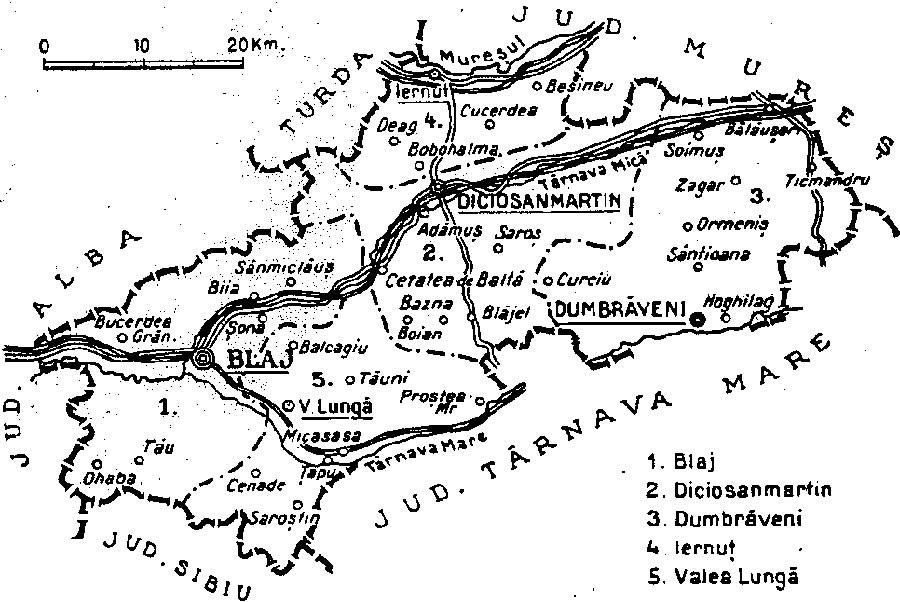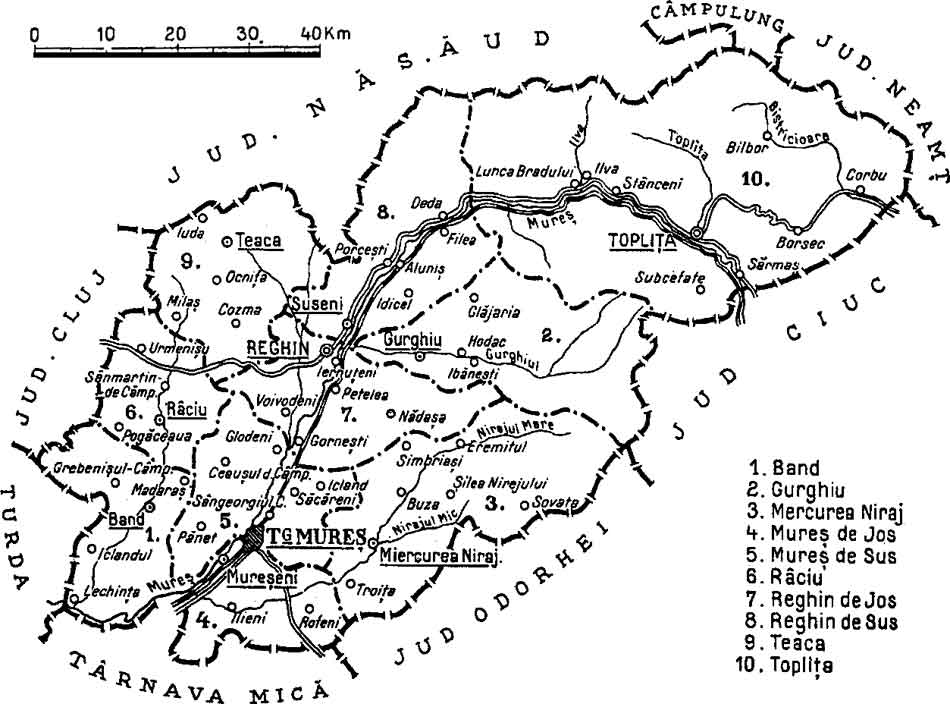|
Târnăveni
Târnăveni (, historically Diciosânmartin; Hungarian language, Hungarian: ''Dicsőszentmárton'', ; German language, German: ''Sankt Martin'', earlier ''Marteskirch'') is a Municipalities of Romania, city in Mureș County, central Romania. It lies on the Târnava Mică River in central Transylvania. The city administers three villages: Bobohalma (''Bábahalma''), Botorca (''Őrhegy''), and Cuștelnic (''Csüdőtelke''); the last was part of Gănești Commune until 2002. In Romanian language, Romanian, it was previously known as ''Diciosânmartin'', then ''Târnava-Sânmărtin''. History Prehistoric period Archaeological research has demonstrated that the presence of human communities in this area dates back thousands of years. In 1921, traces of a Neolithic settlement were discovered. Antiquity A collection of 135 Roman Empire, Imperial Roman ''Denarius, denarii'' and two silver balls were also found. Middle Ages The place was historically certified in 1279, under the name of ... [...More Info...] [...Related Items...] OR: [Wikipedia] [Google] [Baidu] |
Târnava-Mică County
Târnava-Mică County was a county (Romanian language, Romanian: ''județ'') in the Kingdom of Romania, the successor to Kis-Küküllő County of the Kingdom of Hungary. Its capital was Târnăveni, Diciosânmartin (now Târnăveni, in Mureș County) until 1926, and afterwards at Blaj. Geography Târnava-Mică County covered 2,081 km2 and was located in central part of Greater Romania, in the centre of Transylvania. Currently, the territory that comprised the greater part of Târnava-Mică County is now part of Sibiu County, Mureș County, and Alba County. Its borders were as follows: Turda County to the northwest, Mureș County to the northeast, Alba County to the west, Sibiu County and Târnava-Mare County to the south, and Odorhei County to the east. History Prior to World War I, the territory of the county belonged to Austria-Hungary and was identical with the Kis-Küküllő County of the Kingdom of Hungary. The territory of Târnava-Mică County was transferred to Romani ... [...More Info...] [...Related Items...] OR: [Wikipedia] [Google] [Baidu] |
Mureș County
Mureș County (, , ) is a county (''județ'') of Romania, in the Historical regions of Romania, historical region of Transylvania, with the administrative centre in Târgu Mureș. The county was established in 1968, after the administrative reorganization that re-introduced the historical ''județ'' (Counties of Romania, county) system, still used today. This reform eliminated the previous Magyar Autonomous Region, Mureș-Magyar Autonomous Region, which had been created in 1952 within the People's Republic of Romania. Mureș County has a vibrant multicultural fabric that includes Székely Land, Hungarian-speaking Székelys and Transylvanian Saxons, with a rich heritage of Villages with fortified churches in Transylvania, fortified churches and towns. Name In Hungarian language, Hungarian, it is known as ''Maros megye'' (), and in German language, German as ''Kreis Mieresch''. Under Kingdom of Hungary, a county with a similar name (Maros-Torda County, ) was created in 1876. There ... [...More Info...] [...Related Items...] OR: [Wikipedia] [Google] [Baidu] |
Gănești
Gănești (, Hungarian pronunciation: ) is a commune in Mureș County, Transylvania, Romania. It is composed of four villages: Gănești, Păucișoara (''Küküllőpócsfalva''), Seuca (''Szőkefalva'') and Sub Pădure (''Erdőalja''). It also included Cuștelnic village until 2002, when it was transferred to Târnăveni city. The commune is located in the southern part of the county, on the Transylvanian Plateau, at a distance of from Târnăveni. It lies on both banks of the river Târnava Mică and it is traversed by the river Băgaciu (or Bedea). Gănești borders the communes Cucerdea and Ogra to the north, Mica to the east, Băgaciu to the south, and the city of Târnăveni to the west. As of January 1, 2012, the commune had a population of 3,511, of which 2,300 were ethnic Hungarians (65.5%), 862 ethnic Romanians (24.5%), and 346 ethnic Romanis (9.9%). See also *List of Hungarian exonyms (Mureș County) This is a list of Hungarian names for towns and communes ... [...More Info...] [...Related Items...] OR: [Wikipedia] [Google] [Baidu] |
Cetatea De Baltă
Cetatea de Baltă (; ) is a commune in Alba County, Transylvania, Romania. The commune is composed of four villages: Cetatea de Baltă, Crăciunelu de Sus (''Christendorf''; ''Felsőkarácsonyfalva''), Sântămărie (''Frauenkirch''; ''Boldogfalva''), and Tătârlaua (''Taterloch''; ''Felsőtatárlaka''). Geography The commune is located in the northeastern corner of the county, on the border with Sibiu and Mureș counties. It is traversed by county road DJ 117, which connects it to Târnăveni, to the northeast, and to Blaj, to the southeast; the county seat, Alba Iulia, is some past Blaj. To the east it borders with Adămuș commune from Mureș County and with Bazna commune from Sibiu County, to the south and west with Valea Lungă commune, and to the west and north with Jidvei commune. Cetatea de Baltă lies on the left bank of the river Târnava Mică. The river Balta which discharges into the Târnava Mică in the village of Sântămărie. The river Tătârlaua ... [...More Info...] [...Related Items...] OR: [Wikipedia] [Google] [Baidu] |
Comitatus (Kingdom Of Hungary)
Comitatus may refer to: *Comitatus (warband), a Germanic warband who follow a leader * ''Comitatus'', the office of a Roman or Frankish comes, translated as count. * ''Comitatus'', translated as county, a territory such as governed by medieval counts. * Comitatus (Kingdom of Hungary), counties in the Kingdom of Hungary * Comitatenses, armies of the late Roman Empire * Posse comitatus (other), various meanings See also * * Retinue, a body of persons "retained" in the service of a noble or royal person {{disambiguation ... [...More Info...] [...Related Items...] OR: [Wikipedia] [Google] [Baidu] |
Bridge Over The Târnava Mică River In Târnăveni, Romania
A bridge is a structure built to span a physical obstacle (such as a body of water, valley, road, or railway) without blocking the path underneath. It is constructed for the purpose of providing passage over the obstacle, which is usually something that is otherwise difficult or impossible to cross. There are many different designs of bridges, each serving a particular purpose and applicable to different situations. Designs of bridges vary depending on factors such as the function of the bridge, the nature of the terrain where the bridge is constructed and anchored, the material used to make it, and the funds available to build it. The earliest bridges were likely made with fallen trees and stepping stones. The Neolithic people built boardwalk bridges across marshland. The Arkadiko Bridge, dating from the 13th century BC, in the Peloponnese is one of the oldest arch bridges in existence and use. Etymology The ''Oxford English Dictionary'' traces the origin of the word ''bridge' ... [...More Info...] [...Related Items...] OR: [Wikipedia] [Google] [Baidu] |
Prefect
Prefect (from the Latin ''praefectus'', substantive adjectival form of ''praeficere'': "put in front", meaning in charge) is a magisterial title of varying definition, but essentially refers to the leader of an administrative area. A prefect's office, department, or area of control is called a prefecture, but in various post-Roman Empire cases there is a prefect without a prefecture or ''vice versa''. The words "prefect" and "prefecture" are also used, more or less conventionally, to render analogous words in other languages, especially Romance languages. Ancient Rome ''Praefectus'' was the formal title of many, fairly low to high-ranking officials in ancient Rome, whose authority was not embodied in their person (as it was with elected Magistrates) but conferred by delegation from a higher authority. They did have some authority in their prefecture such as controlling prisons and in civil administration. Feudal times Especially in Medieval Latin, ''præfectus'' was used to ... [...More Info...] [...Related Items...] OR: [Wikipedia] [Google] [Baidu] |
Avram Iancu
Avram Iancu (; ; 1824 – September 10, 1872) was a Transylvanian Romanian lawyer who played an important role in the local chapter of the Revolutions of 1848 in the Austrian Empire, Austrian Empire Revolutions of 1848–1849. He was especially active in the Țara Moților region and the Apuseni Mountains. The rallying of peasants around him, as well as the allegiance he paid to the House of Habsburg, Habsburg monarchy, earned him the moniker ''Crăișorul Munților'' ("The Prince of the Mountains").Ion Ranca, Valeriu Nițu, ''Avram Iancu: documente și bibliografie'', Bucharest, Editura Științifică, 1974 (most contemporary documents about Avram Iancu, including his report to Wohlgemuth) Early life Avram Iancu was born in Avram Iancu, Alba, Vidra de Sus (currently Avram Iancu, Alba, Avram Iancu, Alba County), Principality of Transylvania (1711–1867), Transylvania, then part of the Austrian Empire into a family of peasants that had been emancipated from serfdom. His fathe ... [...More Info...] [...Related Items...] OR: [Wikipedia] [Google] [Baidu] |
List Of Rulers Of Moldavia
This is a list of monarchs of Moldavia, from the first mention of the medieval polity east of the Carpathian Mountains, Carpathians and until its disestablishment in 1862, when Unification of Moldavia and Wallachia, it united with Wallachia, the other Danubian Principalities, Danubian Principality, to form the modern-day state of Romania. Notes Dynastic rule is hard to ascribe, given the loose traditional definition of the ruling family (on principle, princes were chosen from any branch, including a previous monarch's bastard sons – being defined as ''os de domn'' – "of Hospodar, domn marrow", or as having ''hereghie'' – "heredity" (from the Latin ''hereditas''); the institutions charged with the Elective monarchy, election, dominated by the boyars, had fluctuating degrees of influence). The system itself was challenged by usurpers, and became obsolete with the Phanariotes, Phanariote epoch, when monarchs were appointed by the Ottoman Empire, Ottoman Ottoman Dynasty, Sultans. ... [...More Info...] [...Related Items...] OR: [Wikipedia] [Google] [Baidu] |
Hungarian Revolution Of 1848
The Hungarian Revolution of 1848, also known in Hungary as Hungarian Revolution and War of Independence of 1848–1849 () was one of many Revolutions of 1848, European Revolutions of 1848 and was closely linked to other revolutions of 1848 in the Habsburg areas. Although the revolution failed, it is one of the most significant events in Hungary's modern history, forming the cornerstone of modern Hungarian national identity—the anniversary of the Revolution's outbreak, 15 March, is one of Hungary's three Public holidays in Hungary, national holidays. In April 1848, Hungary became the third country of Continental Europe (after France, in 1791, and Belgium, in 1831) to enact a law implementing democratic parliamentary elections. The new suffrage law (Act V of 1848) transformed the old feudal parliament (The Estates, Estates General) into a democratic representative parliament. This law offered the widest right to vote in Europe at the time. The April laws utterly erased all pri ... [...More Info...] [...Related Items...] OR: [Wikipedia] [Google] [Baidu] |
Austria-Hungary
Austria-Hungary, also referred to as the Austro-Hungarian Empire, the Dual Monarchy or the Habsburg Monarchy, was a multi-national constitutional monarchy in Central Europe#Before World War I, Central Europe between 1867 and 1918. A military and diplomatic alliance, it consisted of two sovereign states with a single monarch who was titled both the Emperor of Austria and the King of Hungary. Austria-Hungary constituted the last phase in the constitutional evolution of the Habsburg monarchy: it was formed with the Austro-Hungarian Compromise of 1867 in the aftermath of the Austro-Prussian War, following wars of independence by Hungary in opposition to Habsburg rule. It was dissolved shortly after Dissolution of Austria-Hungary#Dissolution, Hungary terminated the union with Austria in 1918 at the end of World War 1. One of Europe's major powers, Austria-Hungary was geographically the second-largest country in Europe (after Russian Empire, Russia) and the third-most populous (afte ... [...More Info...] [...Related Items...] OR: [Wikipedia] [Google] [Baidu] |







